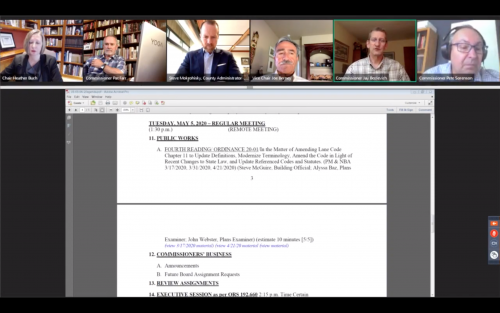
On Tuesday, May 5, the Lane County Board of Commissioners conducted their weekly public meeting via Zoom. During this meeting, they looked at code changes for “temporary campgrounds,” potential shelter options for unhoused youth and the process for reopening Lane County.
Alyssa Baz, plans examiner for the Lane County Building Department, discussed the proposed code change regarding temporary campgrounds in the county.
The change includes requiring individual campsites to be visibly numbered with signage visible from fire access lanes. This would mean that individual tents or clusters of camping spots would have numbered signs marking each one to make them easier to identify in an emergency.
According to Baz, this code doesn’t distinguish between types of different campgrounds — such as recreational camping versus unhoused campsites — but rather applies to all campgrounds equally.
“Any permit that comes in will be required to identify those types of campsites for the quick response of emergency vehicles,” Baz said. “But it will also come in handy for other types of identification or other transportation needs.”
Commissioner Pat Farr responded to this, voicing a concern.
“As we respond to the needs of people who are homeless by giving them sanctioned places to stay,” Farr said. “Sometimes it’s in the city limits, sometimes it’s not in the city limits. We need to make certain that we’re not going to get tripped up at some point and say you can’t put a campground right there because you don’t have numbers.”
But Baz said the numbers don’t necessarily need to denote every spot, it can work for groups of camp spots.
“If you have a very large campground with many different access aisles,” Baz said. “We don’t want the emergency vehicles to have to transverse the whole campground in order to locate where the emergency is.”
County Administrator Steve Mokrohisky next explained the county’s plan to provide shelter for unhoused youth. He says that St. Vincent de Paul is currently working on the project, but the only hold up is the ability to hire qualified staff. The certifications needed to work with vulnerable, at-risk unhoused youth are significant, he said.
Mokrohisky said the county is currently working with Looking Glass Community Services and 15th Night to open a long-term shelter in the future. Recently, a facility owned by Looking Glass became available at the Martin Luther King Jr. Education Center, equipped with 16 beds for youth and around 10,000 square feet of space, according to Mokrohisky.
“As opposed to putting limited resources into retrofitting a youth detention into an unhoused shelter for youth, we are having active conversations with Looking Glass as to whether or not using the facility that they own that is currently vacant, for a long-term use shelter would be a better course,” Mokrohisky said. “Many of us think that it would.”
But Mokrohisky said he recognizes the potential risks of the plan. “It causes more of a public health problem if we have congregate living that is not managed in the right way during a public health pandemic,” he said.
He then went on to discuss the process for reopening Lane County after COVID-19. He said the county’s goal is to make sure reopening happens as quickly and safely as possible, having a consistent framework to work with, rather than “setting up a scenario in which we are either arbitrarily or subjectively determining who can open and who can’t open.”
According to the Lane County Government, as of this writing, there are 59 confirmed COVID-19 cases, two deaths, and no one currently in the hospital.
These meetings are open to the public every Tuesday morning and afternoon via the Lane County website. To participate in commenting, audience members need to register at LaneCounty.org.